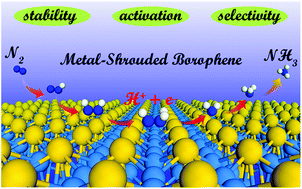Two-dimensional transition metal borides as high activity and selectivity catalysts for ammonia synthesis†
Abstract
In comparison to defect/doping induced activity in materials, transition metal borides with exposed metal atoms, large specific surface area, and high active site density show advantages as durable and efficient catalysts for specific electrochemical reactions. In this work, ReB2 for N2 reduction reaction (NRR) for ammonia (NH3) with a record-low limiting potential of UL = –0.05 V and high Faraday efficiency (FE) of 100% is screened out from a new class of TMB2. It is concluded that high pressure/temperature is favorable to N2 adsorption and kinetic barrier minimization; the maximal turnover frequency (TOF) at 700 K and 100 bar is 1.24 × 10−2 per s per site, which is comparable to that of the benchmark Fe3/Al2O3 catalysts, achieving an extremely fast reaction rate. In addition, crystal orbital Hamilton population (COHP) of *N2 reveals the intrinsic origin of N2 activation by analyzing the d–2π* interactions, and integrated COHP could be a quantitative descriptor to describe the N2 activation degree. It is evident that our results not only identify an efficient NRR electrocatalyst in particular, paving the way for sustainable NH3 production, but also explain the chemical and physical origin of the activity, advancing the design principle for catalysts for various reactions in general.



 Please wait while we load your content...
Please wait while we load your content...